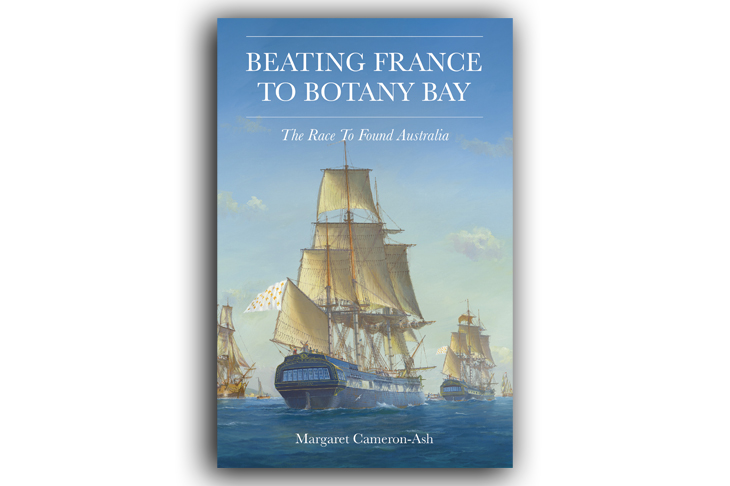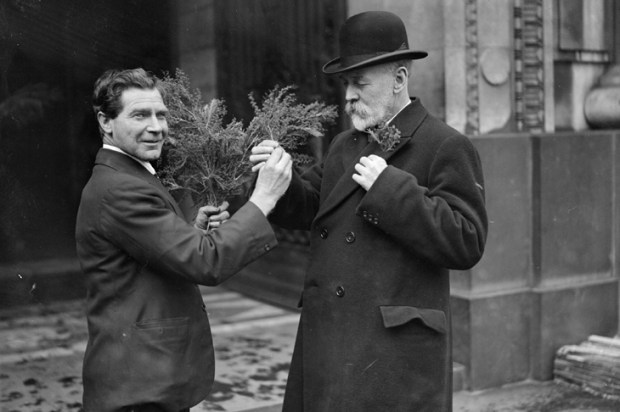For decades the purpose of British settlement in New South Wales seemed too obvious to question. The American War of Independence had robbed Britannia of its penal colony while the criminal class was multiplying. Australia, according to the influential but slipshod historian Manning Clark, offered ‘a remedy for the late, alarming and numerous increase in felons in the country and more particularly in the metropolis’.
Now, thanks to the diligent work of some non-tenured, inquisitive researchers, we know this to be bunkum. Manning Clark’s explanation, amplified by Robert Hughes in The Fatal Shore, has been exposed as fake news, a convenient story to which the British Admiralty gave credence to disguise its real motive: strategic dominance of the Pacific, which in the late 18th century was rapidly gaining importance as a sphere crying out to be influenced.
In Beating France to Botany Bay: The Race to Found Australia, lawyer Margaret Cameron-Ash sets out the argument in forensic detail, revealing the vital piece of intelligence that forced British prime minister William Pitt to change his mind about British interest in the distant continent and commission Captain Arthur Phillip to command the First Fleet. She examines the recommendations of the 1779 Bunbury Commission which rejected the proposal for an Australian penal colony that had been enthusiastically championed by Joseph Banks. By the mid-1780s, the Australian plan had fallen out of the conversation, largely because of the cost. Britain, under King George III, entered a rare phase of fiscal consolidation after the expense of the Seven Years’ War, the first global conflict in history, and was in no mood for indulging the pet projects of enthusiasts like Banks.
Then, seemingly out of nowhere, the Australian plan was back on the table. The British Cabinet met on 17 August 1786 and fired the starting pistol for a race to lead a fleet of settlement to Botany Bay. Cameron-Ash reveals the news that tipped the balance, perhaps the earliest example of joint British-American intelligence. Two French ships, L’Astrolabe and La Boussole under the command of the youthful Jean-François de Galaup de La Pérouse, had arrived in the Pacific laden with what appeared to be a cargo of settlement: trees, plants, seeds, cloth, iron, copper, a range of mechanical tools, and trinkets.
Having recently succeeded in relieving France of its North American colonies and toehold on the Indian sub-continent through the Peace Treaty following the Seven Years’ War, the British Admiralty was not about to allow the strategically important continent of Australia to fall into French hands. Yet to signal that they were despatching a fleet to challenge the French in the Pacific would have been regarded as a declaration of war against its neighbour across the Channel. It would at the very least have spelt the end of the Anglo-French commercial treaty Pitt was on the verge of securing. Hence the need for the cover story that Britain was looking for a dumping ground for convicts in the Antipodes. ‘By constant repetition of the worlds “Botany Bay” and “convicts” the cover story became an idée reçue, creating the illusion of truth, as to both destination and rationale’, writes Cameron-Ash.
Cameron-Ash’s convincing account lays bare the gullibility and, dare we say, laziness of virtually everyone who attempted to chronicle the foundational narrative of Australia before Geoffrey Blainey. Blainey first subjected the penal colony idea to a cost-benefit study in The Tyranny of Distance and drew the obvious conclusion. Cameron-Ash joins the ranks of distinguished recent historians like David Kemp who have weighed up the evidence and arrived at very different conclusions to Manning Clark, whose four-volume History of Australia was once regarded by many as the last word on almost every subject.
That the dishonest telling of our foundational story has persisted for so long is not a trivial matter. The debate about whether January 26 should be a day to mourn or to express patriotic pride overshadows what should be our day of national unity. Until we first get straight in our minds what event we are marking, there is little hope of resolving this perennial dispute.
What’s more, by touching on the Enlightenment origins of Australia, and the classical liberal perspective of influential figures like Pitt, Banks and George III, Cameron-Ash exposes the distortions in the black-armband interpretation of Australian history. The colonists were high-minded idealists committed to peaceful coexistence with the indigenous population. Such atrocities as occurred in the conflict between settlers and indigenous people were not sanctioned by the state. Indeed, as Cameron-Ash points out, Captain Phillip was instructed to establish civil government over New South Wales, rather than military command, from the start. A legal system dedicated to administering the law without fear or favour was operating from day one, prosecuting settlers who committed acts of violence against indigenous people.
Cameron-Ash’s account is all the more refreshing in that the race for Australia was a tale of extraordinary maritime feats, dramatic suspense and derring-do. Phillip beat La Pérouse to Botany Bay by just five days. The First Fleet’s dramatic exit from Botany Bay to reach the intended destination of Sydney Harbour was a triumph in itself, pushed back by electric storms and fierce winds that would be familiar to those who have spent this summer in the New South Wales capital. La Pérouse stayed for six weeks, twice visiting Sydney Cove at Phillip’s invitation before his fateful, final voyage.
It is a story we should be telling our children, in place of the dismal caricature of brute colonialism and oppression that is currently dished out to them or the disgraceful faux history of Bruce Pascoe that still features prominently on the ABC’s website, even after it has been comprehensively discredited by Peter O’Brien, Peter Sutton, Keryn Walshe and others. Could Beating France to Botany Bay find its way onto the national curriculum? We can but hope.
Got something to add? Join the discussion and comment below.
Get 10 issues for just $10
Subscribe to The Spectator Australia today for the next 10 magazine issues, plus full online access, for just $10.
Nick Cater is executive director of the Menzies Research Centre and a director of Quadrant.
You might disagree with half of it, but you’ll enjoy reading all of it. Try your first month for free, then just $2 a week for the remainder of your first year.














Comments
Don't miss out
Join the conversation with other Spectator Australia readers. Subscribe to leave a comment.
SUBSCRIBEAlready a subscriber? Log in